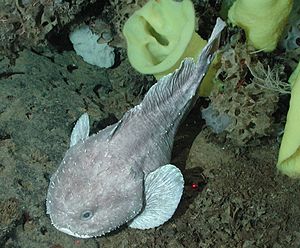Psychrolutes phrictus facts for kids
Quick facts for kids Psychrolutes phrictus |
|
|---|---|
 |
|
| Scientific classification |
The blob sculpin (Psychrolutes phrictus) is a type of deep-sea fish. It belongs to the Psychrolutidae family. This fish mostly eats small sea creatures like crustaceans (like crabs), molluscs (like snails), and sea pens.
It lives in the very deep parts of the Pacific Ocean, near places like Japan, the Bering Sea, and California. It can be found between 839 and 2800 meters (about 2,750 to 9,200 feet) deep. Female blob sculpins lay their eggs and then guard them carefully.
Contents
What Does It Look Like?
The blob sculpin can grow up to 70 centimeters (about 27 inches) long. It has a wide, flat head with big, widely spaced eyes. Its mouth is curved with thick lips.
Unlike some fish, it doesn't have a spine near its gill cover (the bony flap protecting its gills). Its body and head are covered with many small, fleshy threads called cirri. The gill cover itself is soft and covered by a jelly-like layer.
Behind its head, the body quickly gets narrower towards its tail. There's also a jelly-like layer between its skin and muscles. The top fin (dorsal fin) has eight stiff spines and 19 to 20 soft rays. The bottom fin (anal fin) has no spines and 12 to 14 soft rays. Its side fins (pectoral fins) are wide, and bigger fish have fleshy pads near the tips of these fins.
The top part of this fish is grey or black, and its belly is pale. It might also have some faint spots.
Where Does It Live?
The blob sculpin is found in the northeastern Pacific Ocean. It lives on or near the seabed at depths from 500 to 2800 meters (about 1,640 to 9,200 feet).
Life and Reproduction
Scientists have seen groups of blob sculpins using special underwater robots. These fish were found at depths between 1300 and 3000 meters (about 4,265 to 9,840 feet) off the coast of California.
Blob sculpins lay sticky eggs on limestone-like rocks in the deep sea. They are known to guard their large, pinkish eggs in nests. The adult fish often lie on or touch the eggs. The eggs were free of dirt, which suggests the adult fish were actively fanning them to keep them clean. This is the first time scientists have seen deep-sea fish that lay eggs taking care of their young in this way!
Interestingly, many octopuses from the Graneledone family were also found near the sculpins, guarding their own eggs. About half of these octopuses were very close to an adult or breeding sculpin. At one location, researchers saw 84 sculpins and 64 nests, along with many brooding octopuses. They called this area a "reproductive hot spot" because so many animals were raising their young there.
What Does It Eat?
The blob sculpin mainly eats small sea creatures without backbones. These include sea pens, crustaceans (like crabs), and snails. They also eat other things like cephalopods (like squid), crinoids (like sea lilies), sea cucumbers, and even other fish. Some of the fish they eat usually swim in open water, but scientists think the sculpins must catch them when they swim close to the seabed. This is because the blob sculpin's body shape is perfect for living on the bottom of the ocean.
This fish can also be a host for skin parasites. These include tiny creatures called copepods, such as Chondracanthus yanezi and Neobrachiella amphipacifica.
See also
 In Spanish: Chabolito para niños
In Spanish: Chabolito para niños

